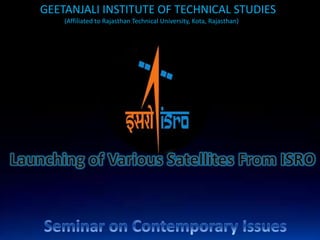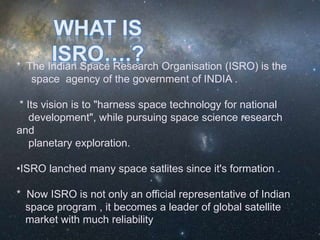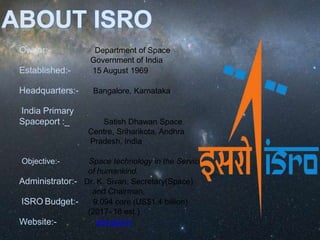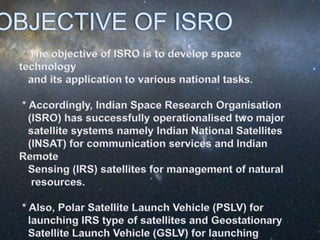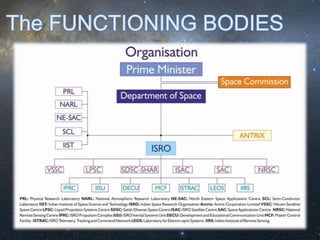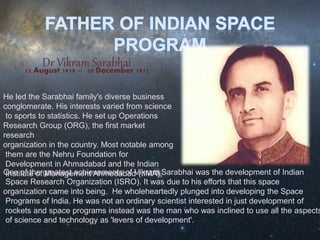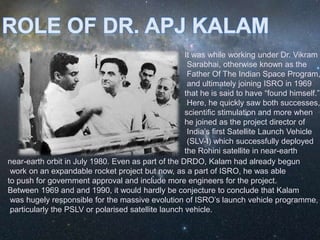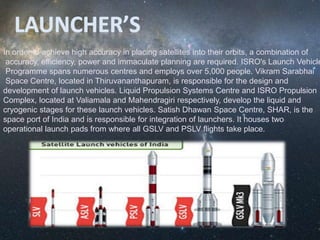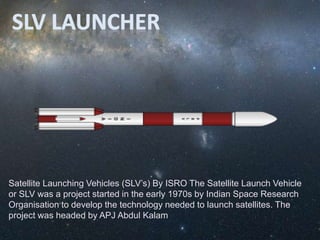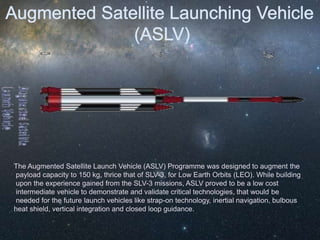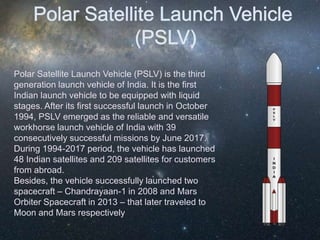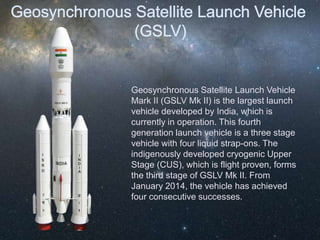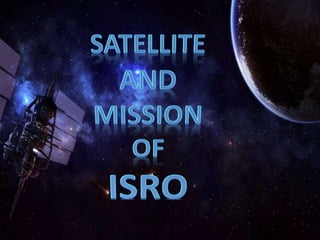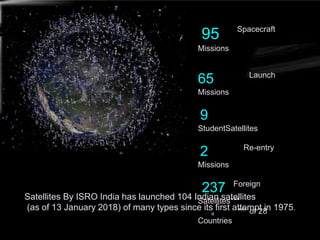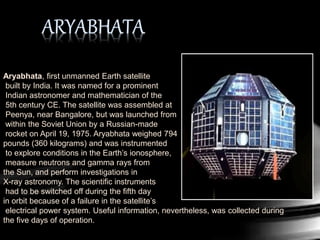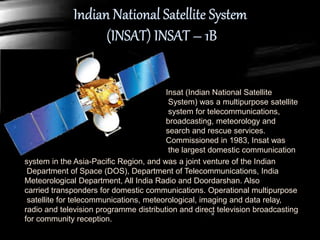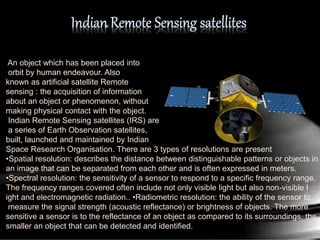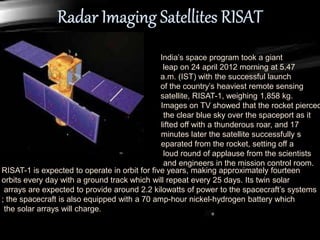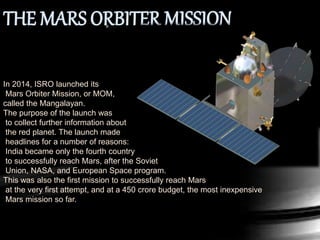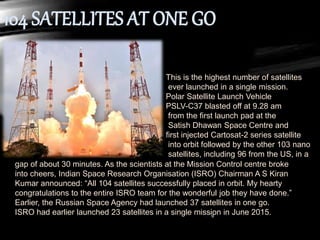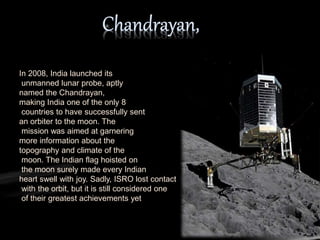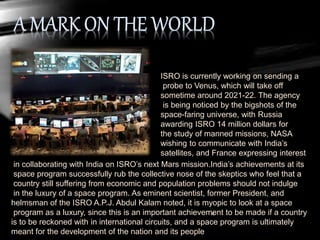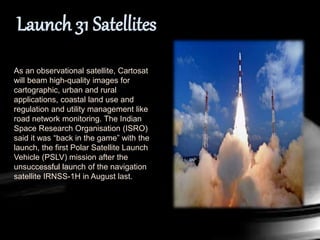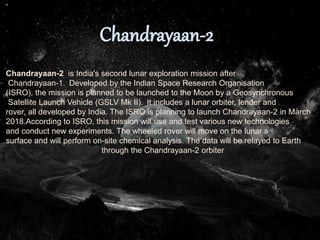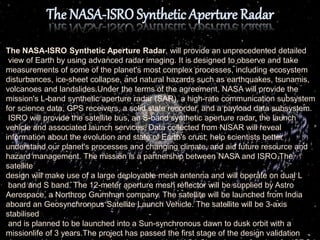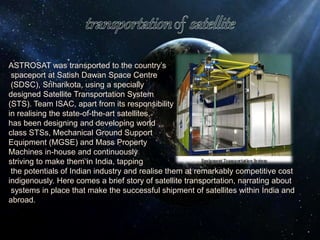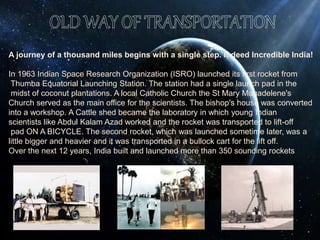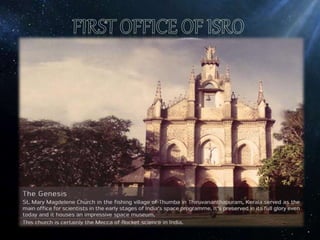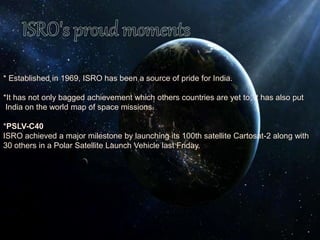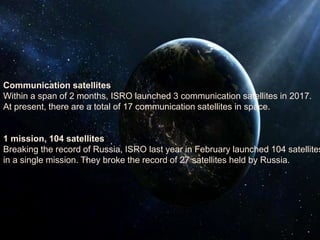Indian Space Research Organisation
- 1. GEETANJALI INSTITUTE OF TECHNICAL STUDIES (Affiliated to Rajasthan Technical University, Kota, Rajasthan)
- 2. * The Indian Space Research Organisation (ISRO) is the space agency of the government of INDIA . * Its vision is to "harness space technology for national development", while pursuing space science research and planetary exploration. •ISRO lanched many space satlites since it's formation . * Now ISRO is not only an official representative of Indian space program , it becomes a leader of global satellite market with much reliability
- 3. Owner:- Department of Space Government of India Established:- 15 August 1969 Headquarters:- Bangalore, Karnataka India Primary Spaceport :_ Satish Dhawan Space Centre, Sriharikota, Andhra Pradesh, India Objective:- Space technology in the Service of humankind. Administrator:- Dr. K. Sivan, Secretary(Space) and Chairman, ISRO Budget:- 9,094 core (US$1.4 billion) (2017–18 est.) Website:- isro.gov.in
- 6. Dr Vikram Sarabhai12 August 1919 -- 30 December 1971 He led the Sarabhai family's diverse business conglomerate. His interests varied from science to sports to statistics. He set up Operations Research Group (ORG), the first market research organization in the country. Most notable among them are the Nehru Foundation for Development in Ahmadabad and the Indian Institute of Management Ahmedabad (IIMA),One of the greatest achievements of Vikram Sarabhai was the development of Indian Space Research Organization (ISRO). It was due to his efforts that this space organization came into being. He wholeheartedly plunged into developing the Space Programs of India. He was not an ordinary scientist interested in just development of rockets and space programs instead was the man who was inclined to use all the aspects of science and technology as 'levers of development'.
- 7. It was while working under Dr. Vikram Sarabhai, otherwise known as the Father Of The Indian Space Program, and ultimately joining ISRO in 1969 that he is said to have “found himself.” Here, he quickly saw both successes, scientific stimulation and more when he joined as the project director of India’s first Satellite Launch Vehicle (SLV-I) which successfully deployed the Rohini satellite in near-earth near-earth orbit in July 1980. Even as part of the DRDO, Kalam had already begun work on an expandable rocket project but now, as a part of ISRO, he was able to push for government approval and include more engineers for the project. Between 1969 and and 1990, it would hardly be conjecture to conclude that Kalam was hugely responsible for the massive evolution of ISRO’s launch vehicle programme, particularly the PSLV or polarised satellite launch vehicle.
- 8. In order to achieve high accuracy in placing satellites into their orbits, a combination of accuracy, efficiency, power and immaculate planning are required. ISRO's Launch Vehicle Programme spans numerous centres and employs over 5,000 people. Vikram Sarabhai Space Centre, located in Thiruvananthapuram, is responsible for the design and development of launch vehicles. Liquid Propulsion Systems Centre and ISRO Propulsion Complex, located at Valiamala and Mahendragiri respectively, develop the liquid and cryogenic stages for these launch vehicles. Satish Dhawan Space Centre, SHAR, is the space port of India and is responsible for integration of launchers. It houses two operational launch pads from where all GSLV and PSLV flights take place.
- 9. Satellite Launching Vehicles (SLV’s) By ISRO The Satellite Launch Vehicle or SLV was a project started in the early 1970s by Indian Space Research Organisation to develop the technology needed to launch satellites. The project was headed by APJ Abdul Kalam
- 10. The Augmented Satellite Launch Vehicle (ASLV) Programme was designed to augment the payload capacity to 150 kg, thrice that of SLV-3, for Low Earth Orbits (LEO). While building upon the experience gained from the SLV-3 missions, ASLV proved to be a low cost intermediate vehicle to demonstrate and validate critical technologies, that would be needed for the future launch vehicles like strap-on technology, inertial navigation, bulbous heat shield, vertical integration and closed loop guidance.
- 11. Polar Satellite Launch Vehicle (PSLV) is the third generation launch vehicle of India. It is the first Indian launch vehicle to be equipped with liquid stages. After its first successful launch in October 1994, PSLV emerged as the reliable and versatile workhorse launch vehicle of India with 39 consecutively successful missions by June 2017. During 1994-2017 period, the vehicle has launched 48 Indian satellites and 209 satellites for customers from abroad. Besides, the vehicle successfully launched two spacecraft – Chandrayaan-1 in 2008 and Mars Orbiter Spacecraft in 2013 – that later traveled to Moon and Mars respectively
- 12. Geosynchronous Satellite Launch Vehicle Mark II (GSLV Mk II) is the largest launch vehicle developed by India, which is currently in operation. This fourth generation launch vehicle is a three stage vehicle with four liquid strap-ons. The indigenously developed cryogenic Upper Stage (CUS), which is flight proven, forms the third stage of GSLV Mk II. From January 2014, the vehicle has achieved four consecutive successes.
- 14. Satellites By ISRO India has launched 104 Indian satellites (as of 13 January 2018) of many types since its first attempt in 1975. 95 Spacecraft Missions 65 Launch Missions 9 StudentSatellites 2 Re-entry Missions 237 Foreign Satellites*** *** of 28 Countries
- 15. Aryabhata, first unmanned Earth satellite built by India. It was named for a prominent Indian astronomer and mathematician of the 5th century CE. The satellite was assembled at Peenya, near Bangalore, but was launched from within the Soviet Union by a Russian-made rocket on April 19, 1975. Aryabhata weighed 794 pounds (360 kilograms) and was instrumented to explore conditions in the Earth’s ionosphere, measure neutrons and gamma rays from the Sun, and perform investigations in X-ray astronomy. The scientific instruments had to be switched off during the fifth day in orbit because of a failure in the satellite’s electrical power system. Useful information, nevertheless, was collected during the five days of operation.
- 16. Insat (Indian National Satellite System) was a multipurpose satellite system for telecommunications, broadcasting, meteorology and search and rescue services. Commissioned in 1983, Insat was the largest domestic communication system in the Asia-Pacific Region, and was a joint venture of the Indian Department of Space (DOS), Department of Telecommunications, India Meteorological Department, All India Radio and Doordarshan. Also carried transponders for domestic communications. Operational multipurpose satellite for telecommunications, meteorological, imaging and data relay, radio and television programme distribution and direct television broadcasting for community reception.
- 17. An object which has been placed into orbit by human endeavour. Also known as artificial satellite Remote sensing : the acquisition of information about an object or phenomenon, without making physical contact with the object. Indian Remote Sensing satellites (IRS) are a series of Earth Observation satellites, built, launched and maintained by Indian Space Research Organisation. There are 3 types of resolutions are present •Spatial resolution: describes the distance between distinguishable patterns or objects in an image that can be separated from each other and is often expressed in meters. •Spectral resolution: the sensitivity of a sensor to respond to a specific frequency range. The frequency ranges covered often include not only visible light but also non-visible l ight and electromagnetic radiation.. •Radiometric resolution: the ability of the sensor to measure the signal strength (acoustic reflectance) or brightness of objects. The more sensitive a sensor is to the reflectance of an object as compared to its surroundings, the smaller an object that can be detected and identified.
- 18. India’s space program took a giant leap on 24 april 2012 morning at 5.47 a.m. (IST) with the successful launch of the country’s heaviest remote sensing satellite, RISAT-1, weighing 1,858 kg. Images on TV showed that the rocket pierced the clear blue sky over the spaceport as it lifted off with a thunderous roar, and 17 minutes later the satellite successfully s eparated from the rocket, setting off a loud round of applause from the scientists and engineers in the mission control room. RISAT-1 is expected to operate in orbit for five years, making approximately fourteen orbits every day with a ground track which will repeat every 25 days. Its twin solar arrays are expected to provide around 2.2 kilowatts of power to the spacecraft’s systems ; the spacecraft is also equipped with a 70 amp-hour nickel-hydrogen battery which the solar arrays will charge.
- 19. In 2014, ISRO launched its Mars Orbiter Mission, or MOM, called the Mangalayan. The purpose of the launch was to collect further information about the red planet. The launch made headlines for a number of reasons: India became only the fourth country to successfully reach Mars, after the Soviet Union, NASA, and European Space program. This was also the first mission to successfully reach Mars at the very first attempt, and at a 450 crore budget, the most inexpensive Mars mission so far.
- 20. This is the highest number of satellites ever launched in a single mission. Polar Satellite Launch Vehicle PSLV-C37 blasted off at 9.28 am from the first launch pad at the Satish Dhawan Space Centre and first injected Cartosat-2 series satellite into orbit followed by the other 103 nano satellites, including 96 from the US, in a gap of about 30 minutes. As the scientists at the Mission Control centre broke into cheers, Indian Space Research Organisation (ISRO) Chairman A S Kiran Kumar announced: “All 104 satellites successfully placed in orbit. My hearty congratulations to the entire ISRO team for the wonderful job they have done.” Earlier, the Russian Space Agency had launched 37 satellites in one go. ISRO had earlier launched 23 satellites in a single mission in June 2015.
- 21. In 2008, India launched its unmanned lunar probe, aptly named the Chandrayan, making India one of the only 8 countries to have successfully sent an orbiter to the moon. The mission was aimed at garnering more information about the topography and climate of the moon. The Indian flag hoisted on the moon surely made every Indian heart swell with joy. Sadly, ISRO lost contact with the orbit, but it is still considered one of their greatest achievements yet
- 22. ISRO is currently working on sending a probe to Venus, which will take off sometime around 2021-22. The agency is being noticed by the bigshots of the space-faring universe, with Russia awarding ISRO 14 million dollars for the study of manned missions, NASA wishing to communicate with India’s satellites, and France expressing interest in collaborating with India on ISRO’s next Mars mission.India’s achievements at its space program successfully rub the collective nose of the skeptics who feel that a country still suffering from economic and population problems should not indulge in the luxury of a space program. As eminent scientist, former President, and helmsman of the ISRO A.P.J. Abdul Kalam noted, it is myopic to look at a space program as a luxury, since this is an important achievement to be made if a country is to be reckoned with in international circuits, and a space program is ultimately meant for the development of the nation and its people
- 23. As an observational satellite, Cartosat will beam high-quality images for cartographic, urban and rural applications, coastal land use and regulation and utility management like road network monitoring. The Indian Space Research Organisation (ISRO) said it was “back in the game” with the launch, the first Polar Satellite Launch Vehicle (PSLV) mission after the unsuccessful launch of the navigation satellite IRNSS-1H in August last.
- 25. Chandrayaan-2 is India's second lunar exploration mission after Chandrayaan-1. Developed by the Indian Space Research Organisation (ISRO), the mission is planned to be launched to the Moon by a Geosynchronous Satellite Launch Vehicle (GSLV Mk II). It includes a lunar orbiter, lender and rover, all developed by India. The ISRO is planning to launch Chandrayaan-2 in March 2018.According to ISRO, this mission will use and test various new technologies and conduct new experiments. The wheeled rover will move on the lunar s surface and will perform on-site chemical analysis. The data will be relayed to Earth through the Chandrayaan-2 orbiter
- 26. The NASA-ISRO Synthetic Aperture Radar, will provide an unprecedented detailed view of Earth by using advanced radar imaging. It is designed to observe and take measurements of some of the planet's most complex processes, including ecosystem disturbances, ice-sheet collapse, and natural hazards such as earthquakes, tsunamis, volcanoes and landslides.Under the terms of the agreement, NASA will provide the mission's L-band synthetic aperture radar (SAR), a high-rate communication subsystem for science data, GPS receivers, a solid state recorder, and a payload data subsystem. ISRO will provide the satellite bus, an S-band synthetic aperture radar, the launch vehicle and associated launch services. Data collected from NISAR will reveal information about the evolution and state of Earth's crust, help scientists better understand our planet's processes and changing climate, and aid future resource and hazard management. The mission is a partnership between NASA and ISRO.The satellite design will make use of a large deployable mesh antenna and will operate on dual L band and S band. The 12-meter aperture mesh reflector will be supplied by Astro Aerospace, a Northrop Grumman company. The satellite will be launched from India aboard an Geosynchronous Satellite Launch Vehicle. The satellite will be 3-axis stabilised and is planned to be launched into a Sun-synchronous dawn to dusk orbit with a missionlife of 3 years.The project has passed the first stage of the design validation
- 27. ASTROSAT was transported to the country’s spaceport at Satish Dawan Space Centre (SDSC), Sriharikota, using a specially designed Satellite Transportation System (STS). Team ISAC, apart from its responsibility in realising the state-of-the-art satellites, has been designing and developing world class STSs, Mechanical Ground Support Equipment (MGSE) and Mass Property Machines in-house and continuously striving to make them in India, tapping the potentials of Indian industry and realise them at remarkably competitive cost indigenously. Here comes a brief story of satellite transportation, narrating about systems in place that make the successful shipment of satellites within India and abroad.
- 28. A journey of a thousand miles begins with a single step. Indeed Incredible India! In 1963 Indian Space Research Organization (ISRO) launched its first rocket from Thumba Equatorial Launching Station. The station had a single launch pad in the midst of coconut plantations. A local Catholic Church the St Mary Magadelene's Church served as the main office for the scientists. The bishop's house was converted into a workshop. A Cattle shed became the laboratory in which young Indian scientists like Abdul Kalam Azad worked and the rocket was transported to lift-off pad ON A BICYCLE. The second rocket, which was launched sometime later, was a little bigger and heavier and it was transported in a bullock cart for the lift off. Over the next 12 years, India built and launched more than 350 sounding rockets
- 30. * Established in 1969, ISRO has been a source of pride for India. *It has not only bagged achievement which others countries are yet to, it has also put India on the world map of space missions. *PSLV-C40 ISRO achieved a major milestone by launching its 100th satellite Cartosat-2 along with 30 others in a Polar Satellite Launch Vehicle last Friday.
- 31. Communication satellites Within a span of 2 months, ISRO launched 3 communication satellites in 2017. At present, there are a total of 17 communication satellites in space. 1 mission, 104 satellites Breaking the record of Russia, ISRO last year in February launched 104 satellites in a single mission. They broke the record of 27 satellites held by Russia.
